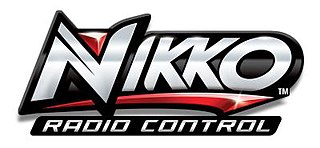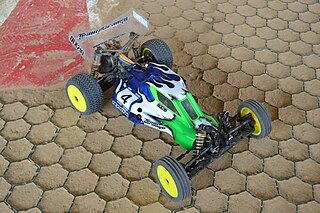Related Research Articles
Radio-controlled cars are miniature model cars or trucks that can be controlled from a distance using a specialized transmitter or remote. The term "RC" has been used to mean both "remote controlled" and "radio controlled", where "remote controlled" includes vehicles that are controlled by radio, infrared or a physical wire connection. Common use of "RC" today usually refers only to vehicles controlled by radio, and this article focuses on radio-controlled vehicles only.
The Tamiya Blackfoot was a 1/10-scale, electric radio controlled model monster truck produced by the Tamiya Corporation of Japan. It was released October 8, 1986 and produced through 1993.
HPI Savage is a line of radio-controlled monster trucks manufactured in Japan by Hobby Products International of Foothill Ranch, California, US.

Mini 4WD is any miniature model within the mini scale of between 1/20 (1:20) to 1/48 (1:48) Scale (ratio). From 1986 to 2019, the term is popularized predominantly (99%) by a 1/30 (1:30) scaled, AA battery powered plastic model race car without remote control. All four (4) wheels are direct-drive, thus "4WD" for 4-wheel drive, as opposed to "AWD" or All-wheel drive. This particular type of Mini 4WD uses horizontal side rollers to guide the vehicle along the vertical walls of the un-banked track for steering, providing speeds from 14 to 65 km/H on the track. At scale,, 1:1 speed represents 420 to 1,950 km/H or 270 to 1,200 mph.

Tokyo Marui Co. Ltd is a Japanese manufacturer of airsoft guns and toy cars located in Adachi, Tokyo, and are famous for pioneering the design of battery-powered airsoft guns. Their products are principally sold in Japan, but are also exported worldwide.
The Tamiya Sand Scorcher was the sixteenth 1/10-scale electric radio controlled car kit released by Japanese model manufacturer Tamiya Corporation. First introduced on December 15, 1979, its high level of detail and realism make it one of the most sought-after vintage R/C models today.
The Associated RC18T is a 1:18 scale, ready-to-run electric stadium truck made by Associated Electrics of Lake Forest, California. A mechanically similar monster truck version with slightly different bodywork similar to the 1:8 scale, nitromethane-powered Associated "Monster GT" and all-terrain tires with unique "AE" tread pattern is sold as the RC18MT.
The Team Losi Mini-T is the first-ever 1/18th scale electric radio-controlled stadium truck made by Team Losi of Ontario, California.
The Tamiya Clod Buster is a 1/10-scale radio controlled monster truck released September 21, 1987 by the Tamiya Corporation. With its four-wheel drive, four-wheel steering, twin Mabuchi RS-540 motors and 165 mm tires it quickly became one of Tamiya's most popular radio controlled model kits.
Kyosho Corporation is a model car company based in Tokyo, Japan. The brand operates internationally under the name KYOSHO. The company's main office is located in Chiyoda, Tokyo, and the production headquarters are located in Atsugi, Kanagawa.

Nikko R/C is the largest toy-grade radio control manufacturer in the world. The company's licenses include those from Dodge, Ford, Volkswagen, Chevrolet, Porsche, as well as proprietary designs. In 2014, Nikko was acquired by global toy company, Toy State. In 2017, Toy State created a new arm of the Nikko brand, Nikko Air. In 2019 Nikko Toys Ltd. became the new home of the Nikko RC brand.
The TT-01 is a 1/10 scale shaft-driven R/C chassis made by Tamiya. Since its release in 2003, the TT-01 has become a very popular entry-level chassis, especially for drifting and rallying applications. The bathtub chassis frame combined with the central driveshaft makes it a durable car for everyday surfaces, and its relatively light weight plastic chassis and cut-out mounting positions for the battery and motor gives it a low center of gravity. Both in Europe and the US the TT-01 is the de facto choice for 24-hour endurance races. These events see teams of competitors, hobbyists, and friends build their TT-01 kit at the track the morning of the race then compete for 24 hours with teams of 5-8 people just like the races at Lemans and Daytona. Tamiya's recent addition of LED lights in most of their TT-01 kits sees these races take on an even more realistic look as the cars sport head and tail lights at night.
The Tamiya TXT-1, which stands for Tamiya eXtreme Truck, was one of Tamiya's 1/10 scale radio controlled (RC) Monster Trucks.
Tamiya Rough Rider was the very first of Tamiya's SRB series. These according to Tamiya made Radio Control Models accessible to everyone. The design is famous for its fibre glass chassis with rear torsion bars and front hairpin springs. These models originally cost 18,000 yen. They are very popular these days to collectors being first in the series that produced legends like the Sand Scorcher and the Super Champ. These days, MIB examples of this model are very rare and change hands for a lot of money. Even what can only be described as wrecks change hands for good money.
The Monogram Lightning was an early 1/10-scale electric radio controlled offroad buggy kit marketed in North America in 1984 by static kit manufacturer Monogram Models. A variation with slightly different bodywork was known as the Thunder.
The Tamiya Radio Controlled Nitro Off-road Vehicles entered the radio controlled (RC) nitro engine powered 1/8 scale truck market in July 2002. Produced by the Tamiya Corporation of Japan, these 1/8 scale trucks are designed for stadium competition. Tamiya's first nitro truck, TR-15, was introduced in 1994. Second truck was Mad Bison, released in 2000. Third attempt, Terra Crusher, departed greatly from the previous two. Terra Crusher (TG-01), released in July 2002, capitalized on the off-road monster RC boom of the time; subsequent trucks include the Wild Commando, TNX (TGM-03), TNX 5.2R, and Nitrage. The trucks perform in competitions for Remotely Operated Auto Racers (ROAR) abbreviated as ROAR. ROAR is the sanctioning body of competitive radio-controlled car racing in the United States and Canada, overseen by IFMAR.

Aoyagi Metals Industry Co. Ltd was a Japanese company that became notable in the 1980s for its radio-controlled cars.

The 1:10 radio-controlled off-road buggy is a 1:10 scale radio-controlled dune buggy designed for off-road racing. These cars are originally based on their full-scale equivalents that are commonly found in desert racing. The buggies are split into two race categories, two (2WD) and four-wheel drive (4WD). These can easily be distinguished visually by their wheel size at the front. Cars are typically electric powered, but nitro versions do exist but are less common because racing classes exist for electric cars. The class is inexpensive and similar to a number of other classes, and this makes them popular with newcomers. The cars are also known as 1/10 off-road.
Designed by Yuichi Kanai the Kyosho Inferno is a 1/8 scale, four-wheel-drive, off-road competition buggy which was first released in late 1991 as the successor to the Kyosho Turbo Burns. As with the Burns series that came before it, each model has several versions with different factory specifications to suit specific budgets and skill levels. The first generation (MP3/MP4), now referred to as the "classic Inferno", was produced from late 1991 to the end of 1996 and won every IFMAR 1:8 IC Off-Road World Championship during its production run. With eight world titles under its belt, the Kyosho Inferno has been the most successful RC car in its scale and deserves the "fire"-themed brand name which has been in use since the release of the Kyosho Burns in 1988.
References
- ↑ "Archived copy". Archived from the original on 2012-03-24. Retrieved 2011-05-19.CS1 maint: archived copy as title (link)